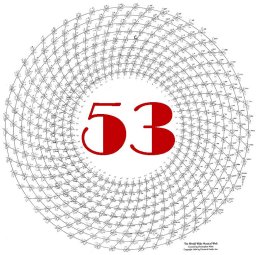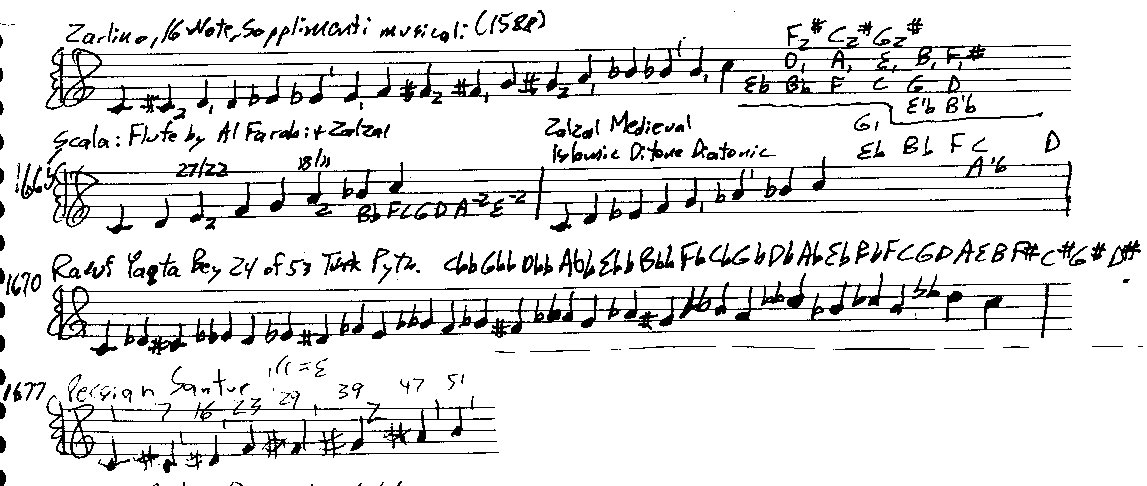Next Page: 8/5 – Other Middle East Scales
Persia, Turkey
Persian musical culture goes back to around 400 A.D. At one time the Persian Empire included what are now Iran, Afghanistan, Pakistan, Tajikistan, Turkmenistan, Azerbaijan, Armenia, Georgia, Turkey, Iraq, Lebanon, Palestine, Israel, UAE, Syria, Jordan, Kuwait, Qatar, Egypt, Bahrain, Uzbekistan and parts of India, Saudi Arabia, China, Kyrgyzstan and Greece. These countries are still influenced by Persian musical culture in varying degrees. By 700 A.D., the music theorist Barbod created seven categories of modes (30 modes in all) from which he derived 360 melody maps known as dastan. The intervals in these modes include the 19:18 minor second (90 cents, C-C1#), the 13:12 small neutral tone (135 cents, C-C1#), the 11:10 large neutral tone (160 cents, C2#), the 9/8 whole tone (204 cents, C-D) and the 7:6 plus-tone or septimal minor third (267 cents, C-E1b).
After Islam spread to Persia, Persian and Arabic musical systems tended to merge. The Arabian peninsula now consists of 9 countries: Kuwait, Bahrain, Qatar, and the United Arab Emirates (UAE) on the east, Oman on the southeast, Yemen on the south and Saudi Arabia at the center. Another 13 countries, most in North Africa, are strongly culturally tied in with Arabic cultural and musical traditions. Local traditions differ from Persian and Arabic countries, of course. Some Persian theorists appear to have also adopted a 3-limit system. The Persian-influenced Egyptian flute tuned to A has holes creating an 11-note mostly-chromatic scale (with no tritone): (Figure 8-6)
C – G — D – A – E – B – F# — C# — G# — D# — A# or A – A# — B – C – C# — D – E – F – F# — G – G# — A
The great Persian Islamic philosopher and music theorist Al-Farabi (born in Kazakhstan around 950 A.D.) left us a cornucopia of scales influenced by his research into ancient Greek music. The Zarlino and Bey hyperchromatic “scales” are actually templates from which 5 or 7=note scales are built, much like the 22-note-to-the-octave srutis of India. Here are some ancient Persian scales and scale palettes of Al-Farabi and others:
Figure 8-7
This is just the beginning of a chapter rich in ancient tunings from the Middle East. The Al-Farabi scales are over 1400 years old, and they are a treasure trove of some of the most exquisite scales ever invented. If you would like to learn more about this chapter, “Persia, Turkey,” you can buy the entire book, The Grand Unified Theory of Music, in pdf form for $25 with hundreds of embedded musical examples of scales and chords from all over the world.
A free introduction to what The Grand Unified Theory of Music offers is on this website and includes both text and a few musical examples from each webpage. If you would like to learn more about this chapter and the full contents of this entire e-book, you can buy The Grand Unified Theory of Music for $25, with hundreds of embedded musical examples of scales and chords from all over the world — and ideas for how to set up your computer system —
HERE.
You’ll get a personalized password you can use to see the entire e-book. Inside the full book, you will also get a link to the complete pdf file of this e-book, which you can read on your Kindle or similar device. The links to the hundreds of mp3 sound files – the same ones you can hear on the website — will also be included. This is “Version 1.0” of The Grand Unified Theory of Music. Because it is an e-book, additions, corrections and improvements in the sound may be added at any time. The Grand Unified Theory of Music is Copyright © 2018 by Christopher Mohr. All rights reserved.
One person per password. Sharing this password with others is a violation of copyright. Do not allow others to use your password or link to the pdf file!

